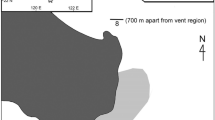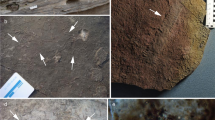Abstract
Dense animal assemblages consisting of vestimentiferan worms, brachyuran crabs and giant clams have been found clustered around deep-sea hydrothermal vents in unusual ecosystems that appear to be independent of photosynthetically produced nutrients. Reduced compounds such as H2S, H2 and CH4 are spewed from the vents into the cold, oxygenated bottom water1,28, and it has been suggested that chemoautotrophic bacteria are important primary producers of organic nutrients ultilized by the vent fauna2–7. In some instances, sulphur-oxidizing bacteria may perform this function through growth as symbionts8,9 within tissues of host animals (clams and vestimentiferans). To gain further insight into sulphur metabolism in these unusual food webs, we have analysed the stable sulphur isotope ratios (34S/32S) of Pacific vent fauna and find δ34S values close to 0‰. These values approximate the +1 to +4‰ range observed for sulphur-bearing minerals at the vents, and indicate that this specialized fauna utilizes sulphur derived from the vents (rather than from seawater sulphate) during growth and metabolism.
This is a preview of subscription content, access via your institution
Access options
Subscribe to this journal
Receive 51 print issues and online access
$199.00 per year
only $3.90 per issue
Buy this article
- Purchase on Springer Link
- Instant access to full article PDF
Prices may be subject to local taxes which are calculated during checkout
Similar content being viewed by others
References
Edmond, J. M., Von Damm, K. L., McDuff, R. E. & Measures, C. I. Nature 297, 187–191 (1982).
Rau, G. H. Science 213, 338–340 (1981).
Rau. G. H. Nature 289, 484–485 (1981).
Williams, P. M., Smith, K. L., Druffel, E. M. & Linick, T. W. Nature 292, 448–449 (1982).
Felbeck, H. & Somero, G. N. Trend. biochem. Sci. 7, 201–204 (1982).
Ruby, E. G., Wirsen, C. O. & Jannasch, H. W. Appl. envir. Microbiol. 42, 317–324 (1981).
Tuttle, J. H., Wirsen, C. O. & Jannasch, H. W. Mar. Biol. 73, 293–299 (1983).
Cavanaugh, C. M., Gardiner, S. L., Jones, M. L., Jannasch, H. W. & Waterbury, J. B. Science 213, 340–341 (1981).
Cavanaugh, C. M. Nature 302, 58–61 (1983).
Tabatabai, M. A. & Bremner, J. M. Agron. J. 64, 40–44 (1972).
Fry, B., Scalan, R. S., Winter, J. K. & Parker, P. L. Geochim. cosmochim. Acta 46, 1121–1124 (1982).
Thode, H. G., Monster, J. & Dunford, H. B. Geochim. cosmochim. Acta 25, 159–174 (1961).
Kaplan, I. R., Emery, K. O. & Rittenberg, S. C. Geochim. cosmochim. Acta 27, 297–331 (1963).
Mekhtiyeva, V. L., Pankina, R. G. & Gavrilov, Ye. Ya. Geochim. Int. 1976, 82–87 (1976).
Schiff, J. A. & Frankhauser, H. in Biology of Inorganic Nitrogen and Sulphur (eds Bothe, H. & Trebst, A) 153–168 (Springer, Berlin, 1981).
Huovinen, J. A. & Gustafsson, B. E. Biochim. biophys. Acta 136, 441–447 (1967).
Schneider, J. F. & Westly, J. J. biol. Chem. 244, 5735–5744 (1969).
Curtis, C. G., Bartholomew, T. C., Rose, F. A. & Dodgson, K. S. Biochem. Pharmac. 21, 2313–2321 (1972).
Ivanov, M. V., Gogotova, G. I., Matrosov, A. G. & Zyakun, A. M. Mikrobiologiya 45, 757–762 (1976).
Karavaiko, G. I., Miller, Yu. M., Kapustin, O. A. & Pivovarova, T. A. Mikrobiologiya 49, 849–854 (1980).
Kaplan, I. R. & Rittenberg, S. C. J. gen. Microbiol. 34, 195–212 (1964).
Chambers, L. A. & Trudinger, P. A. Geomicrobiol. J. 1, 249–293 (1979).
Arp, A. J. & Childress, J. J. Science 219, 295–297 (1983).
Powell, M. A. & Somero, G. N. Science 219, 297–299 (1983).
Terwilliger, R. C., Terwilliger, N. B. & Arp, A. Science 219, 981–983 (1983).
Fry, B. Fish. Bull. (in the press).
Styrt, M. M. et al. Earth planet. Sci. Lett. 53, 382–390 (1981).
Welhan, J. A. & Craig, H. Geophys. Res. Lett. 6, 829–831 (1979).
Author information
Authors and Affiliations
Rights and permissions
About this article
Cite this article
Fry, B., Gest, H. & Hayes, J. Sulphur isotopic compositions of deep-sea hydrothermal vent animals. Nature 306, 51–52 (1983). https://doi.org/10.1038/306051a0
Received:
Accepted:
Issue Date:
DOI: https://doi.org/10.1038/306051a0
This article is cited by
-
Niche partitioning of hydrothermal vent fauna in the North Fiji Basin, Southwest Pacific inferred from stable isotopes
Marine Biology (2022)
-
Mixotrophic chemosynthesis in a deep-sea anemone from hydrothermal vents in the Pescadero Basin, Gulf of California
BMC Biology (2021)
-
Stable isotope analysis in deep-sea chondrichthyans: recent challenges, ecological insights, and future directions
Reviews in Fish Biology and Fisheries (2017)
-
Stable isotopes provide new insights into vestimentiferan physiological ecology at Gulf of Mexico cold seeps
Naturwissenschaften (2011)
-
Heterogeneous energetic pathways and carbon sources on deep eastern Mediterranean cold seep communities
Marine Biology (2010)
Comments
By submitting a comment you agree to abide by our Terms and Community Guidelines. If you find something abusive or that does not comply with our terms or guidelines please flag it as inappropriate.



